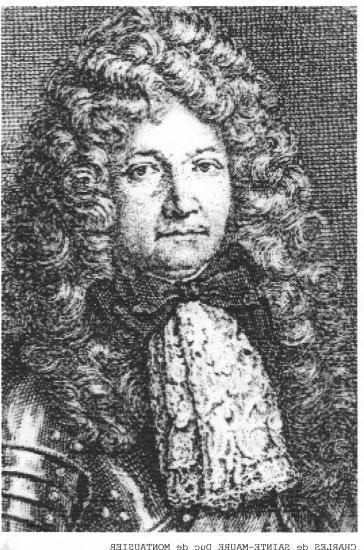Name Charles Sainte-Maure, | ||
 | ||
Died November 17, 1690, Paris, France Children Marie-Julie de Sainte-Maure Grandchildren Julie Francoise de Crussol d'Uzes Similar People Louis - Grand Dauphin, Philip III of France, Henry IV of France, Philip VI of France, Charles IV of France | ||
Charles de Sainte-Maure, duc de Montausier (6 October 1610 – 17 November 1690) was a French soldier and the governor of the dauphin, Louis le Grand Dauphin, the eldest son and heir of Louis XIV, King of France.

Biography
Charles was born on 6 October 1610, being the second son of Léon de Sainte-Maure, baron de Montausier. His parents were Huguenots, and he was educated at the Protestant Academy of Sedan under Pierre Du Moulin. He served brilliantly at the siege of Casale in 1629. Becoming marquis de Montausier at the death of his elder brother in 1635, he was the recognised aspirant for the hand of the marquise de Rambouillet's daughter, Julie d'Angennes (1607-1671). Having served under Bernard of Saxe-Weimar in Germany in 1634, he returned to the French service in 1636, and fought in the Rhenish campaigns of the following years. He was taken prisoner at Rantzau in November 1643, and only ransomed after ten months of captivity.
On his return to France, he became a lieutenant-general. On 15 July 1645, he married "the incomparable Julie," thus terminating a fourteen-year courtship famous in the annals of French literature because of the Guirlande de Julie, a garland of verses consisting of madrigals by Montausier, Claude de Malleville, Georges de Scudéry, Pierre Corneille (if Octave Uzanne is correct in the attribution of three of the six poems signed M.C.), Philippe Habert, Simon Arnauld de Pomponne, Jean Desmarets de Saint Sorlin, Antoine Gombaud (Le nain de la Princesse Julie) and others. It was copied by the famous calligraphist Nicolas Jarry in a magnificent manuscript, on each page of which was a flower painted by Nicolas Robert, and was presented to Julie on her fête day in 1641.
Montausier had bought the governorship of Saintonge and Angoumois, and became a Roman Catholic before his marriage. During the Fronde, he remained faithful to the Crown in spite of personal grievances against Mazarin. On the conclusion of peace in 1653, the marquis, who had been severely wounded in 1652, obtained high favour at court in spite of the roughness of his manners and the general austerity which made the Parisian public recognize him as the original of Alceste in Molière's Le Misanthrope.
Montausier received from Louis XIV the order of the Saint Esprit, the government of Normandy, a dukedom, and in 1668 the office of governor of the dauphin, Louis le Grand Dauphin (1661-1711). He initiated the series of classics ad usum Delphini, directed by the learned Huet, and gave the closest attention to the education of his charge, who was only moved by his iron discipline to a hatred of learning. Montausier died on 17 November 1690.
Court gossip assigned some part of Montausier's favour to the complaisance of his wife, who, appointed lady-in-waiting to the queen in 1664, favoured Louis XIV's passion for Louise de la Vallière, and subsequently protected Madame de Montespan, who found refuge from her husband with her.
